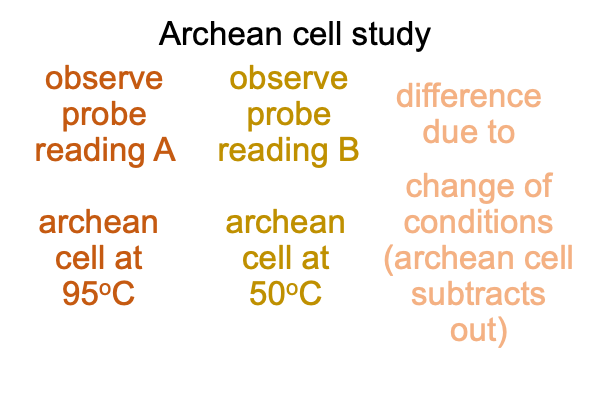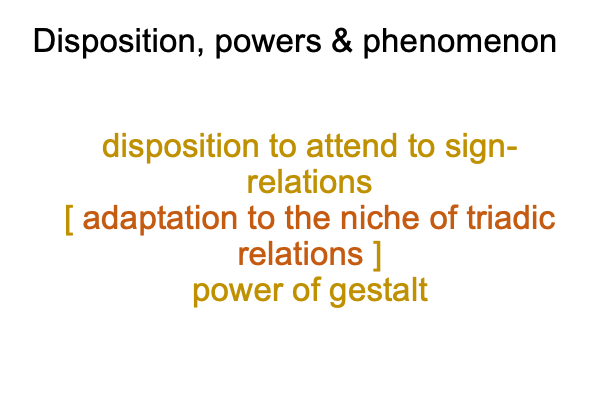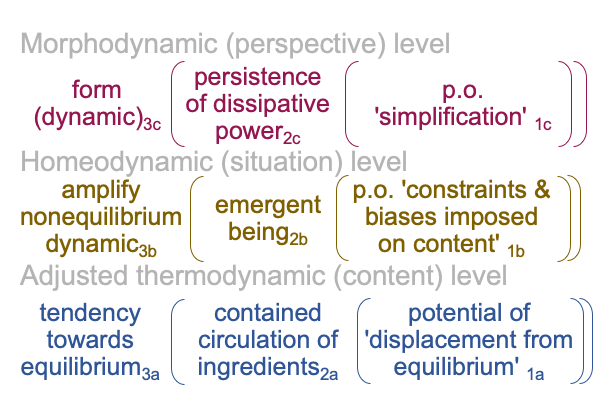0214 In this thought experiment, the researcher has developed a silicon diode imprinted to measure the concentration of 1000 chemicals, including a suite for fatty acids and other lipids. In the laboratory, this probe is placed in contact with an archaean hot spring cell colony at 95oC (scalding hot water) and then the temperature is lowered to 50oC (very warm water), a temperature low enough that cells may start to die.
Here is a picture of the experiment.

0215 The probe measures (among other chemicals) biochemical breakdown products of phosphorylated lipids with branching alkane chains.
0216 Certainly, advances in silicon-imprint technology allows the construction of a probe capable of collecting dense on-the-fly information of biological systems in vivo. The scientist promotes the relevance of system-oriented approaches, along with the desirability of the novel probe, capable of scientifically investigating organisms holistically (without chopping them up), dynamically (on the fly, in vivo and in situ), and across hierarchical organization (by holding the entire living thing as a constant, of sorts).
0217 What does this example imply?
A reductionist can game the system. Let funding from the national science foundation continue!
0218 Does the reductionist know what he is assuming?
Can the comparison of systems approach (as content-level everyday science) be situated by triumphalist modelism or logical positivism?
After all, the resulting models apply to the phenomena of changing conditions, not to the thing itself.
0219 What is the thing itself?
Is it a colony of single-celled creatures obtained from a particular hot springs?
Or, is it found in the materials and methods section of a science research grant?
0220 Admittedly, Tabaczek does not explicitly mention reductionists gaming the system by treating emergent phenomena as “a system”. Let trifles pass. There are rumors of widespread failures to reproduce the results published in scientific journals in biochemistry and related fields. So, maybe, my fashioning this archaean cell example out of whole cloth is not out of the ordinary. Perhaps, in the next few years, I will be able to purchase an artificial general intelligence programthat can conduct additional imaginary research for me.
0221 If Tabaczek is correct, the thing itself is not found in the materials and methods section of a research paper…. er…. grant.
What is the most amazing feature of the noumenon?
Is it the fact that humans recognize noumena, intuitively and instantly, because we are attuned to their signs? Is that what humans are adapted to do? Surely, psychologists can observe and measure gestalt recognition under varying conditions. Are we (humans) living examples of the application of Gestalt theory? Or is Gestalt theory a model of us that is so pertinent that we might as well call ourselves, Homo gestaltus.
Well, that is what a triumphalist modelist would have me believe.
0222 Instead, I follow Tabaczek’s dispositional metaphysics and situate the everyday science of gestalt with the following situation-level hylomorphe1b.

0223 Classical accounts of emergence (section 1.3) sound like gestalt. If an observer asks, “How do you recognize that archaean cell colony in the hot spring is a noumenon?”, I must answer, “I don’t know.”
And, if I did try to formulate a thoughtful response, my answer would be as discombobulated as the various philosophical theories of emergence. Tabaczek labors in these fields. Tabaczek elevates Deacon’s account of emergence because it honors his own intuition. Emergent phenomena belong to a noumenon with “dynamical depth”.
0224 First, emergent phenomena are grounded in a natural flow. They do not violate the laws of thermodynamics. In prior examples, “thermodynamics” names the content-level of a three-level interscope.
0225 Second, they capture energy from that natural flow. As such, they appear to violate the laws of thermodynamics. But, they do so in particular locations and manners. Situational energy-capture carries Deacon’s label, “homeodynamics”.
0226 Third, the capture persists because the siphoned free energy is dissipated by producing structures or processes called “dynamic forms”. These forms catch the human gaze. That is to say, a dynamical form acts as a sign-vehicle that stands for a sign-object, a noumenon, in regards to a sign-interpretant, consisting of an adaptation to the ultimate human niche. This recognizable feature is called, “morphodynamics”.
What is a sign-relation?
A sign is a triadic relation.
A sign-vehicle stands for a sign-object in regards to a sign-interpretant.
0227 Fourth, morphodynamic structures and processes appear designed.
But, we do not know who designed them or what they are designed for.
In other words, we may presume that an emergent noumenon is a sign-object, arising from a sign-vehicle that should reveal the who and the what of its design, in regards to a sign interpretant, consisting of the normal context of encountering emergent phenomena arising from the potential of… um… ‘recognizing a gestalt’.
0228 What do items one through four tell me?
Dynamical depth is a gestalt, an instant recognition of whole, whose parts are articulated in Deacon’s philosophical construction of the adjusted thermodynamic, homeodynamic and morphodynamic interscope.

